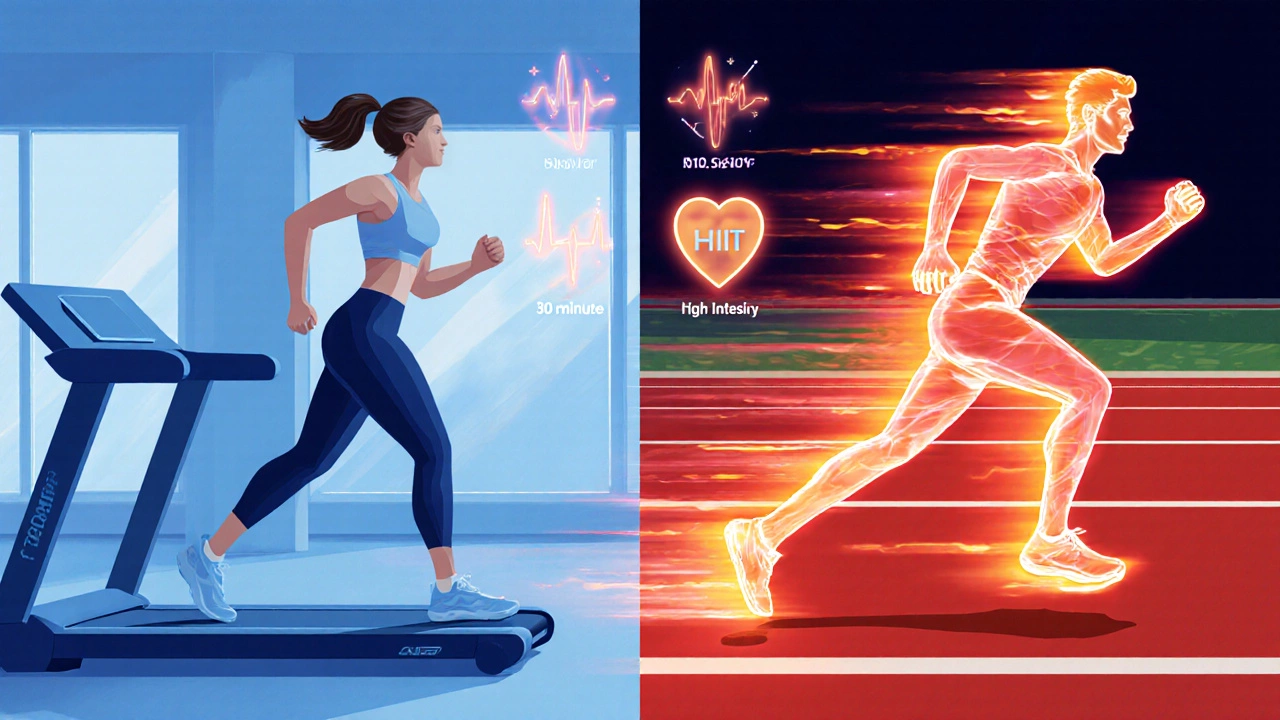
Estimate your calorie burn during 30 minutes of cardio based on your weight, activity, and intensity.
Pro Tip: The article shows that 30 minutes of cardio daily can help create a calorie deficit. To lose 0.5kg per week, you need a daily deficit of about 550kcal.
You’ve probably heard the claim that a half‑hour of cardio every day is the magic ticket to a slimmer waist. In 2024, a study from the Australian Institute of Sport showed participants who stuck to 30minutes of moderate aerobic work lost an average of 1.2kg over twelve weeks - but only when they kept their eating habits in check. So, is that daily half‑hour truly enough?
TL;DR: 30minutes of cardio can contribute to weight loss, but it only works if you stay in the right intensity zone, maintain a calorie deficit, and complement the effort with smart nutrition or strength work.
30 minutes of cardio refers to a continuous 30‑minute bout of aerobic activity performed at moderate‑to‑vigorous intensity, such as brisk walking, cycling, rowing, or jogging. The quality of those 30 minutes matters more than the clock‑time alone.
Every minute you move, your body uses energy measured in kilocalories (kcal). The amount depends on three variables:
As an example, a 70‑kg (154‑lb) person jogging at 6mph for 30minutes burns roughly 350kcal (70kg × 9.8MET × 0.5hr). That same person walking briskly would expend about 150kcal.
The World Health Organization and Australian Dietary Guidelines both suggest at least 150minutes of moderate‑intensity or 75minutes of vigorous‑intensity aerobic activity per week for general health. If you do a consistent 30‑minute session each day, you’re hitting 210minutes - well above the baseline.
| Guideline | Minimum per Week | Your Daily 30‑min Plan | Result |
|---|---|---|---|
| WHO (moderate) | 150min | 30min×7days = 210min | +40% |
| WHO (vigorous) | 75min | 30min×7days = 210min | +180% |
| Australian Guidelines (moderate) | 150min | 210min | +40% |

Even within that 30‑minute window, how hard you push yourself changes the outcome.
| Aspect | Steady‑State (30min) | HIIT (30min total) |
|---|---|---|
| Typical Intensity | Moderate (50‑70%HRmax) | High‑Intensity intervals (85‑95%HRmax) |
| Calories Burned During Session | ~300kcal (70kg jog) | ~350kcal (including rest periods) |
| Post‑Exercise Oxygen Consumption (EPOC) | Low | Elevated for 24‑48hrs |
| Time Efficiency | Longer continuous effort | Short bursts, same total time |
| Suitability for Beginners | High | Medium - requires proper warm‑up |
HIIT (High‑Intensity Interval Training) can keep your metabolism revved up for hours after you finish, a phenomenon called excess post‑exercise oxygen consumption (EPOC). If you’re pressed for time, swapping two steady‑state days for a HIIT session can boost weekly calorie burn without extending the total minutes.
All the cardio in the world won’t move the needle if your overall energy balance stays neutral or positive. Weight loss fundamentally comes down to a calorie deficit the state where total calories expended exceed calories consumed over a given period.
Here’s a quick rule of thumb: a deficit of ~7,700kcal corresponds to roughly 1kg (2.2lb) of fat loss. To lose 0.5kg per week, you need a daily deficit of about 550kcal. That can be achieved through a mix of diet and exercise.
When cardio and diet work together, the pathway to weight loss becomes smoother.
Relying solely on cardio can leave you missing out on strength training resistance exercises that stimulate muscle growth and improve metabolic rate. More muscle means a higher resting metabolic rate (RMR), so you burn more calories even when you’re not moving.
Research from the University of Melbourne (2023) showed participants who added two 45‑minute strength sessions per week to their cardio routine lost 30% more fat than cardio‑only peers, despite similar calorie deficits.

Bottom line: 30minutes of cardio daily is a solid foundation, but it becomes truly effective when you keep intensity in check, stay in a calorie deficit, and add muscle‑building work. If you stick to these basics, you’ll see the scale move, the waist shrink, and your energy levels rise.
You can, but progress will be slow. A 30‑minute jog burns about 300kcal; you’d need to do that daily and avoid any extra snacking to create a 500‑kcal daily deficit. Most people find modest diet tweaks far easier than burning that many extra calories through exercise alone.
A brisk walk at 3.5mph (5.6km/h) hits roughly 3.5METs, which falls into the moderate‑intensity range for most adults. Slower strolls stay below that threshold and won’t count toward the recommended cardio dose.
For beginners, 1‑2 HIIT sessions per week mixed with 3‑4 steady‑state days works well. As fitness improves, you can raise HIIT to 3 times weekly, but always include at least one lower‑intensity day for recovery.
Not double, but significant. Strength work boosts muscle mass, lifting resting calories by about 5‑10% and improves insulin sensitivity. Combined with cardio, many see a 20‑30% faster fat loss rate compared to cardio alone.
It helps keep you in the target zone, but you can also gauge intensity by talking: if you can speak in short sentences, you’re likely in the moderate range; if you’re only able to say a few words, you’re in vigorous mode.